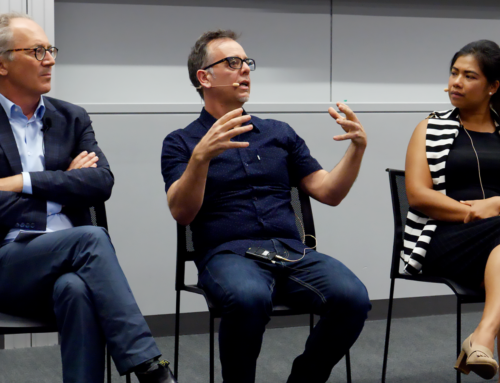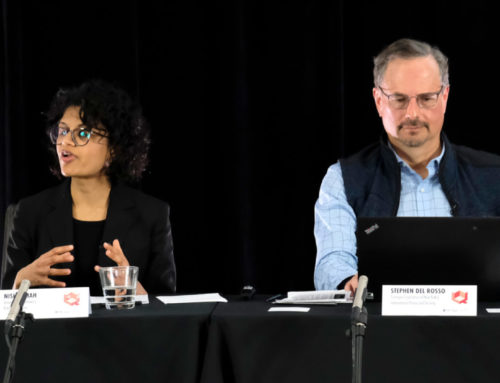After flights spanning continents and oceans and the International Date Line providing an element of quantum tunneling to their adventures, arrivals to the Q Symposium were met by the manicured greens of the University of Sydney’s Quadrangle. A Victorian outpost perched on a hill above the sleek architecture of the city and campus, the environs were an apt place to launch a project seeking complementarity between the old and the new of security studies.

The University of Sydney Quadrangle, site of the 7th Annual Michael Hintze Lecture in International Security (Photo: Ben Foldy)
Opening the proceedings was Professor Duncan Ivison, Dean of the Arts and Social Science faculty at the University of Sydney, who highlighted the work being done at the University’s Centre for International Security Studies to make USyd a nexus point of cutting edge security research and introducing the Centre’s recently appointed director, Michael Hintze Chair of International Security Studies, and organizer of the Q Symposium, James Der Derian.

Professor Duncan Ivison, Dean of the Faculty of Arts and Social Sciences at University of Sydney, introduces CISS Director James Der Derian (Photo: Jose Torrealba)
In his remarks, Der Derian spoke to a vision that the Q Symposium would signal a new era for CISS, reorienting the Centre towards breaking global events on the horizon. The Centre will be seeking to lead cutting edge research in biosecurity, infosecurity, geosecurity, and global security in preparing global responses and research to emergent global threats. The Q Symposium, uniting practitioners, theoreticians and observers from across the social and physical sciences and beyond, is one of the first manifestations of steps in this new direction.

CISS Director and Michael Hintze Chair of International Security Studies James Der Derian speaks about his vision for CISS before introducing Lene Hansen (Photo: Jose Torrealba)
After thanking Dean Ivison and Michael Hintze, namesake of both the speech and his chair at CISS, James introduced Lene Hansen, a similarly visionary ally he’d invited to herald IR’s potential for a quantum turn with the opening 7th Annual Michael Hintze Lecture in International Security. After highlighting Hansen’s pioneering research in gender and security, cyber attacks, and the Copenhagen school of securitization theory, Der Derian also spoke to strengthening ties between both the ascendant Sydney school of security studies with its Copenhagen counterpart (represented at the conference by Hansen and Rebecca Adler-Nissen) and their respective host nations, through the recent addition of Tasmanian blood to the Danish Royal Family.
Since her path-breaking work on textual analysis in IR in Security as Practice: Discourse Analysis and the Bosnian War, Hansen has broadened her theoretical lens to integrate the systematic study of images into securitization. Her talk, entitled “In Defence of the Visual Interest: Diplomatic Responses to Image Crisis,” spoke to the nascent research program’s potential to introduce a method of integrating images to international relations.

Lene Hansen, of the University of Copenhagen, speaking on her new research on the study of images in international relations (Photo: Jose Torrealba)
Highlighting the kind of interdisciplinary work that both CISS and the Q Symposium aim to propagate, Hansen drew from communication and media studies, art history, and critical theory to conceptualize a study of globalized images and icons, from the “traditional” media-dominated 1990s of the “CNN Effect” through to the rapid decentralization of image production and dispersion capable of turning Danish editorial cartoons into a worldwide governance crisis.
Though still early days for the research program, Hansen was able to provide some basic frameworks for working in considerations of images to the study of international politics.
First, researchers need to be wary of reproducing a dichotomy that has developed a notion of images as “emotional” in opposition to the rational of text. Emotionality, Hansen claimed, is historically created and (re)produced, privy to the same meaning-making, identity-constituting processes of construction as text. Images, much like materiality in Hansen’s earlier work, do not “speak” for themselves or provide us with self-evident collectivities.
She then laid out five components to be taken into account when connecting image to policy, using an example of an infamous Daily Mirror cover from 1992. First is the image itself. Then comes the literal framing of the image, in captions and headlines, giving images an element of intertextuality. Bold headlines proclaiming internment camps for Bosnian Musims as “Belsen 92” made evident intertextual links to collective memories of the Holocaust. The image itself also makes “inter-visual” connections to similar photographs of Nazi concentration camps. More text, claiming the picture “shames the world” makes explicit the connections of the image to policy discourses in imploring that action should be undertaken. Lastly, subsequent discussions over the veracity and framing of the photograph provide consideration of the construction of the image itself.

Lene Hansen, University of Copenhagen, in front of a recent image of Australia’s controversial shark culling. (Photo: Jose Torrealba)
From here, Hansen expounded on her points through illustrations with other examples, namely images of the desecrated corpses of contractors in Fallujah and David Cerny’s controversial “Entropa” sculpture. The piece, chosen to represent the Czech Republic’s EU presidency, depicted Europe as a model kit of various stereotypes, including a Bulgaria memorably represented by “Turkish” squat toilets.
After concluding her presentation, the crowd comprised of both attendees of the Q Symposium as well as students and faculty from the University, both relayed to Hansen their appreciation of the insightful work and questioned her on the program’s potential yield on matters as diverse as memes, moving images and the ethical commitments of the researcher towards the image subject. The Q Symposium had officially begun with the presentation of an innovative, inter-disciplinary research program and the kind of collaborative spirit that carried over into conversations at the post-presentation reception and dinner going well into the night.








[…] and expansiveness of the conference’s topics, this is no easy task. But just as last year’s lecture by Lene Hansen on images in security spoke to themes that would recur throughout the conference, McKenzie Wark’s […]
[…] so many facets of security studies, natural and social science, ethics, epistemology, and security aesthetics that a single closing panel would have to serve more pledge for future research than summation of […]
[…] as skilled technicians. In her closing, Mackenzie left her mark a symposium already showing a repeated emphasis on imagery, with slides showing convicted PFC Chelsea (née: Bradley) Manning before and […]
[…] relations. While there were some clear similarities to the nascent research program outlined by Lene Hansen in her Hintze lecture two days earlier, Bleiker presented elements of a broad line of research he has been pursuing for […]
[…] the tone, Friday’s first panel took the baton from the groundbreaking research presented in her lecture the day prior and continued the discussion of new frontiers in IR. Entitled “The Q Effect: […]